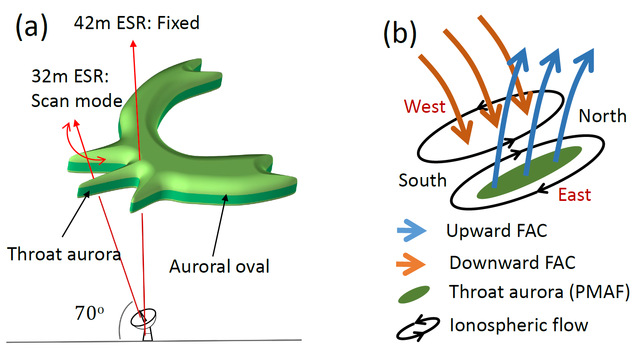De‐Sheng Han1 , Tong Xu2 , Yaqi Jin3 , K. Oksavik4,5 , Xiang‐Cai Chen6 , Jian‐Jun Liu6 , Qinghe Zhang7 , Lisa Baddeley4,5 , and Katie Herlingshaw4,5
1 State Key Laboratory of Marine Geology, School of Ocean and Earth Science, Tongji University, Shanghai, China,
2 National Key Laboratory of Electromagnetic Environment, China Research Institute of Radiowave Propagation,Qingdao, China,
3 Department of Physics, University of Oslo, Oslo, Norway,
4 Birkeland Centre for Space Science, Department of Physics and Technology, University of Bergen, Bergen, Norway
5 The University Centre in Svalbard,Longyearbyen, Norway,
6 SOA Key Laboratory for Polar Science, Polar Research Institute of China, Shanghai, China,
7 Shandong Provincial Key Laboratory of Optical Astronomy and Solar‐Terrestrial Environment, Institute of Space Sciences, Shandong University, Weihai, China
Abstract:
Throat auroras have been suggested to be related to indentations on the subsolar magnetopause. However, the indentation generation process and the resulting ionospheric responses have remained unknown. An EISCAT Svalbard Radar experiment was designed to run with all‐sky cameras, which enabled us for the first time to observe the temporal and spatial evolution of flow reversals, Joule heating, and ion upflows associated with throat aurora. The high‐resolution data enabled us to discriminate that the flow bursts and Joule heating were concurrent and co‐located, but were always observed on the west side of the associated throat auroras, reflecting that the upward/downward field‐aligned currents associated with throat aurora are always to the east/west, respectively. These results are consistent with the geometry of Southwood (1987) flux transfer event model and provide strong evidence for throat aurora being associated with magnetopause reconnection events. The results also support a conceptual model of the throat aurora.

Full Airticle:https://agupubs.onlinelibrary.wiley.com/doi/abs/10.1029/2019GL083593


